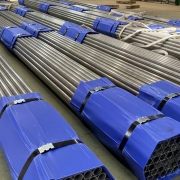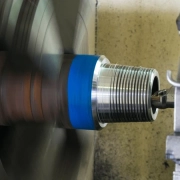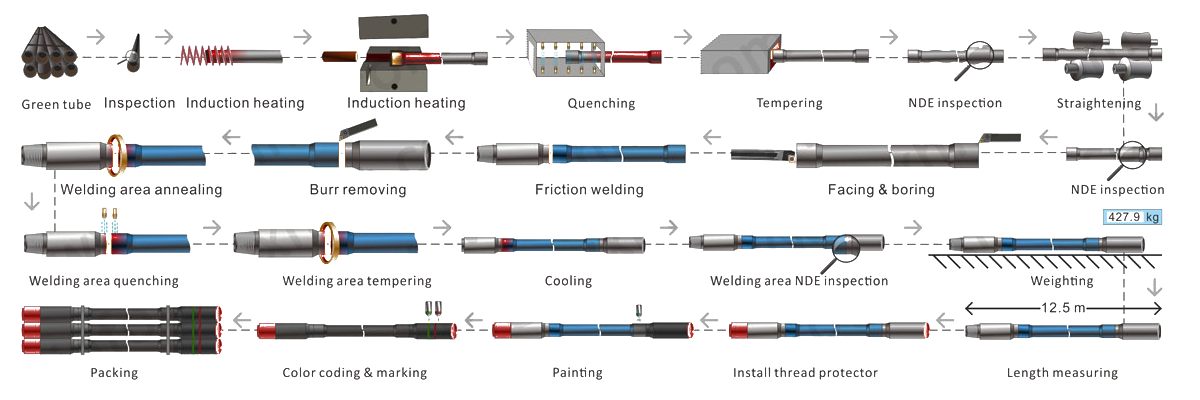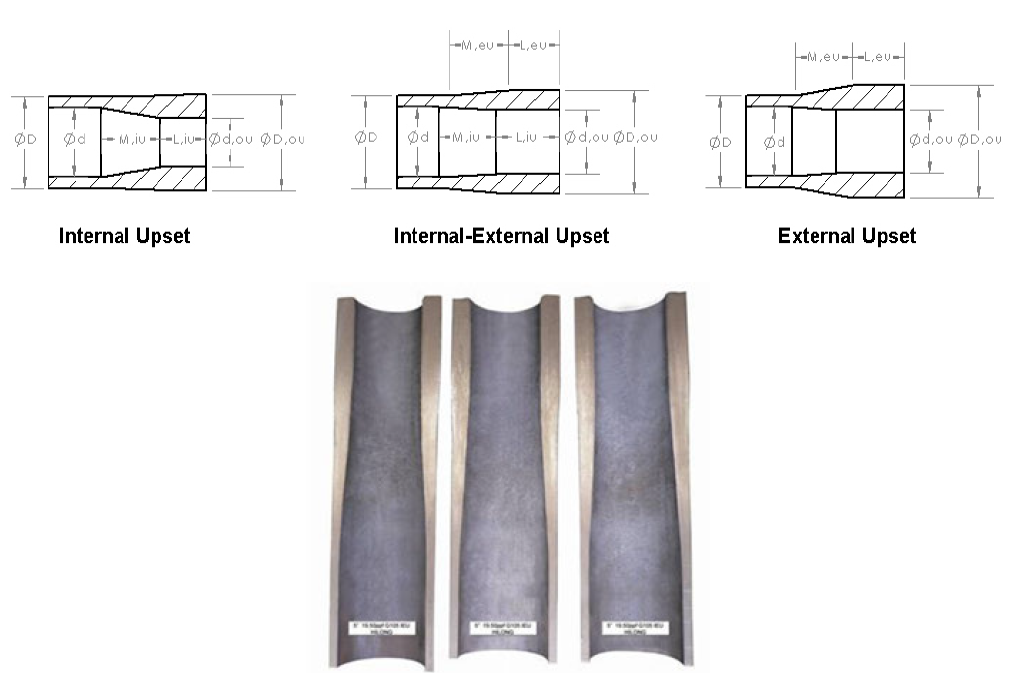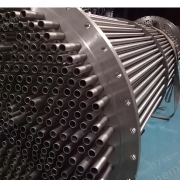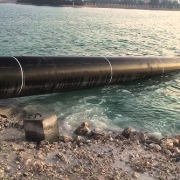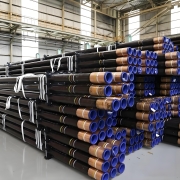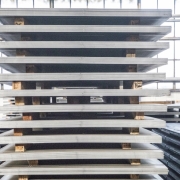09CrCuSb: The Most Ideal Steel for H2SO4 Dew Point Corrosion Resistance
Introduction
When it comes to industrial applications like boilers, heat exchangers, economizers, and air preheaters, material selection plays a pivotal role in ensuring efficiency, longevity, and resistance to various forms of corrosion. Among these, sulfuric acid dew point corrosion remains one of the most challenging issues. Enter 09CrCuSb (ND steel)—a specialized low-alloy steel designed specifically to combat sulfuric acid dew point corrosion. In this post, we’ll explore how ND steel works, why it’s essential for your operations, and how it can be leveraged for long-term, reliable performance in demanding environments.
The Problem: Sulfuric Acid Dew Point Corrosion
In industrial equipment like boilers and heat exchangers, flue gases are often by-products of combustion. These gases contain sulfur oxides (SOx), which, when combined with water vapor, form sulfuric acid (H2SO4). When the temperature of the equipment surface falls below the dew point of sulfuric acid (typically between 120°C and 150°C), the acid condenses and starts to corrode the steel surfaces. This phenomenon, known as dew point corrosion, is particularly problematic in equipment that handles gas at lower temperatures, such as economizers and air preheaters.
Left unchecked, sulfuric acid corrosion can lead to:
- Rapid material degradation.
- Increased maintenance costs.
- Reduced operational efficiency.
- Risk of equipment failure, leading to downtime.
The Solution: 09CrCuSb (ND Steel)
Developed specifically to withstand sulfuric acid dew point corrosion, 09CrCuSb (ND steel) is a low-alloy steel that combines corrosion resistance with mechanical strength, making it the material of choice for industries dealing with flue gases and acidic environments.
Key features of ND steel include:
- Excellent Sulfuric Acid Resistance: The inclusion of chromium (Cr), copper (Cu), and antimony (Sb) enhances the steel’s ability to resist sulfuric acid corrosion, especially in high-dew-point conditions.
- Low-Temperature Performance: ND steel exhibits superior performance in low-temperature environments typical of economizers and air preheaters, where sulfuric acid condensation is most likely to occur.
- High Strength and Durability: The alloy composition ensures that the steel remains strong and durable under the stress of fluctuating temperatures and corrosive conditions, reducing the need for frequent replacements or repairs.
- Cost-Effective Maintenance: While ND steel may have a higher upfront cost compared to other materials, its longevity and corrosion resistance translate into significant cost savings over time due to fewer repairs and less downtime.
Common Applications
ND steel is particularly useful in industrial applications where sulfuric acid corrosion is a concern:
- Boilers: The presence of sulfur-containing fuel in boilers makes ND steel an ideal choice for parts that are susceptible to acid dew point corrosion, such as heat-exposed surfaces.
- 열교환기: In applications where the temperature drop results in condensation of sulfuric acid, ND steel offers a protective solution, increasing the lifespan of heat exchanger tubes.
- Economizers: Located in the cooler sections of the flue gas path, economizers are prone to dew point corrosion. ND steel’s resistance helps maintain efficiency and reduce operational costs.
- Air Preheaters: These components are at significant risk due to the cooling of flue gases, making ND steel crucial for durability and performance in acidic environments.
Key Advantages of Using 09CrCuSb in These Applications
- Improved Operational Lifespan: ND steel’s exceptional resistance to sulfuric acid prolongs the life of boilers, heat exchangers, and air preheaters, reducing the need for frequent replacements.
- 유지 관리 비용 절감: Thanks to its durability, ND steel minimizes the need for repairs, saving both time and money. Reduced corrosion also means fewer emergency shutdowns, improving overall system reliability.
- 효율성 향상: By mitigating the damaging effects of dew point corrosion, ND steel helps maintain the efficiency of heat transfer in boilers and heat exchangers, leading to optimal energy usage and lower fuel costs.
- Safety Enhancement: Corrosion can lead to dangerous equipment failures, particularly in high-temperature and pressure environments. ND steel’s corrosion resistance reduces the likelihood of such failures, improving operational safety.
Key Considerations When Choosing ND Steel
While 09CrCuSb offers a multitude of benefits, it’s essential to approach its implementation with careful consideration. Here are a few factors to keep in mind:
- Temperature Conditions: While ND steel is highly effective at temperatures close to the sulfuric acid dew point, for very high-temperature environments, alternative materials might need to be used in conjunction.
- 비용 대 이점: Although ND steel may have a higher upfront cost, the savings on long-term maintenance, downtime, and replacement justify the investment, especially in sulfur-rich environments.
- Installation Expertise: Proper installation and welding techniques are critical to unlocking the full benefits of ND steel. Ensure that your service providers are experienced with this specialized material to avoid installation-related issues.
Corrosion Rate Comparison of ND Steel and Other Steels in Sulfuric Acid Environments
One of the most critical considerations when selecting materials for industrial applications prone to sulfuric acid dew point corrosion is the corrosion rate in sulfuric acid solutions. To further emphasize the superiority of 09CrCuSb (ND steel), let’s compare its corrosion rate to other common steels such as CR1A, 1Cr18Ni9, S-TEN 1 & 2, 20G, CORTEN-A, A3 (Q235B), in a 70°C, 50% H2SO4 (sulfuric acid) solution for 24 Hours.
Corrosion Rate Data
The table below provides a comparison of corrosion rates for different steels, expressed in mm/year in a solution of 70°C/50% H2SO4/24 Hours:
| Steel Type | Corrosion Rate (mg/cm²h) | Corrosion Rate (mm/a) (a=annual) |
| 09CrCuSb (ND Steel) | 7.3 | 8.18 |
| CR1A | 13.4 | 15.01 |
| 1Cr18Ni9 | 21.7 | 24.30 |
| S-TEN 1 & 2 | 27.4 | 30.69 |
| 20G | 56.4 | 63.17 |
| CORTEN-A | 63.0 | 70.56 |
| A3 (Q235B) | 103.5 | 115.92 |
Key Observations:
- 09CrCuSb (ND Steel) offers the best corrosion resistance among all the materials listed, with a corrosion rate of only 7.3 mg/cm²h 그리고 8.18 mm/year. This indicates that ND steel is highly effective in environments exposed to sulfuric acid, particularly in flue gas systems, economizers, and air preheaters.
- CR1A 그리고 1Cr18Ni9 (stainless steels) show moderate corrosion resistance but still underperform compared to ND steel. They are commonly used in acidic environments, but their corrosion rates of 13.4 mg/cm²h 그리고 21.7 mg/cm²h respectively are still considerably higher than ND steel’s.
- S-TEN 1 & 2 steels, which are specialized corrosion-resistant materials, exhibit corrosion rates of 27.4 mg/cm²h 그리고 30.69 mm/year, much higher than ND steel. While these steels are still suitable for acid-resistant applications, ND steel outperforms them in sulfuric acid exposure.
- 20G 그리고 CORTEN-A both have very high corrosion rates, at 56.4 mg/cm²h 그리고 63.0 mg/cm²h respectively, making them unsuitable for long-term use in environments where sulfuric acid dew point corrosion is prevalent.
- A3 (Q235B) shows the highest corrosion rate, at 103.5 mg/cm²h 그리고 115.92 mm/year, confirming its unsuitability for any applications that involve sulfuric acid exposure, especially in low-temperature sections of flue gas systems.
Why ND Steel Outperforms Others
그만큼 09CrCuSb (ND steel) achieves its remarkable corrosion resistance due to the presence of chromium (Cr), copper (Cu), 그리고 antimony (Sb) in its composition. These elements form a protective layer on the steel surface when exposed to sulfuric acid, drastically slowing down the corrosion process. This protective film is both chemically stable and resistant to the acidic environment, thus offering better long-term performance than other steel types.
- 크롬(Cr) increases corrosion resistance by forming a thin oxide layer that acts as a barrier.
- 구리(Cu) enhances resistance in acidic environments by improving the steel’s overall durability.
- Antimony (Sb) contributes to the stabilization of the passive layer, further inhibiting corrosion, particularly in sulfuric acid.
How to Extend the Life of Your Equipment with ND Steel
To maximize the benefits of ND steel and extend the life of your industrial equipment, consider the following best practices:
- Routine Inspections: Regularly inspect areas exposed to sulfuric acid and high temperatures to catch any early signs of wear or corrosion.
- Proper Cleaning and Maintenance: Clean your equipment frequently to prevent sulfur buildup, which can accelerate corrosion even with corrosion-resistant materials.
- Optimal Operating Temperatures: Ensure that your equipment operates within the recommended temperature range to avoid excessive thermal stress that could compromise material integrity.
- Partner with Trusted Suppliers: Work with suppliers who understand your specific needs and can provide high-quality 09CrCuSb materials, as well as technical support for installation and maintenance.
결론
The data clearly shows that 09CrCuSb (ND Steel) is far superior to the other steels listed when it comes to resisting sulfuric acid corrosion. Its corrosion rate is significantly lower than common alternatives like CR1A, S-TEN, 그리고 CORTEN-A. Therefore, ND steel is an excellent choice for industrial applications where long-term performance, safety, and reduced maintenance costs are critical—such as in boilers, heat exchangers, and economizers exposed to acidic flue gases.
In industrial applications where sulfuric acid dew point corrosion is a serious concern, 09CrCuSb (ND steel) stands out as a reliable, durable, and cost-effective solution. Its combination of strength, corrosion resistance, and performance in harsh environments makes it an excellent choice for equipment like boilers, heat exchangers, economizers, and air preheaters. By choosing ND steel, industries can enhance operational efficiency, reduce downtime, and minimize long-term maintenance costs.
If you’re looking to protect your industrial equipment from sulfuric acid corrosion and extend its operational lifespan, 09CrCuSb (ND steel) is a material that deserves serious consideration. For more detailed technical information or consultation on how to implement ND steel in your systems, contact an expert today.

